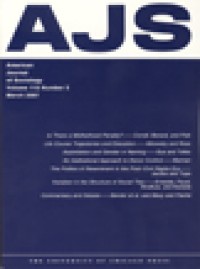
Journal Articles
Three Worlds of Relief: Race, Immigration, and Public and Private Social Welfare Spending in American Cities, 1929
Using a data set of public and private relief spending for 295 cities, this article examines the racial and ethnic patterning of social welfare provision in the United States in 1929. On the eve of the Depression, cities with more blacks or Mexicans spent the least on social assistance and relied more heavily on private money to fund their programs. Cities with more European immigrants spent the most on relief and relied more heavily on public funding. Distinct political systems, labor market relations, and racial ideologies about each group’s proclivity to use relief best explain relief spending differences across cities.
Availability
No copy data
Detail Information
- Series Title
-
The American Journal of Sociology
- Call Number
-
-
- Publisher
- Chicago : The University of Chicago Press., 2010
- Collation
-
-
- Language
-
English
- ISBN/ISSN
-
00029602
- Classification
-
-
- Content Type
-
-
- Media Type
-
-
- Carrier Type
-
-
- Edition
-
Volume 116. No. 2, September 2010.pp. pp. 453-502
- Subject(s)
- Specific Detail Info
-
-
- Statement of Responsibility
-
-
Other version/related
No other version available
File Attachment
No Data
Comments
You must be logged in to post a comment
 Computer Science, Information & General Works
Computer Science, Information & General Works  Philosophy & Psychology
Philosophy & Psychology  Religion
Religion  Social Sciences
Social Sciences  Language
Language  Pure Science
Pure Science  Applied Sciences
Applied Sciences  Art & Recreation
Art & Recreation  Literature
Literature  History & Geography
History & Geography